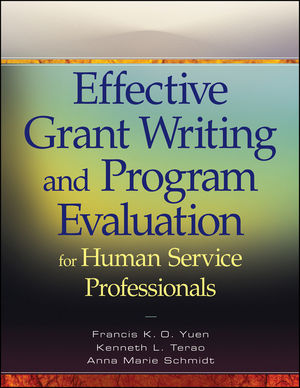Effective Grant Writing and Program Evaluation for Human Service ProfessionalsISBN: 978-0-470-46998-9
Paperback
288 pages
July 2013
 |
||||||
Acknowledgments xi
About the Authors xiii
About the Contributors xv
Chapter 1 Introduction 1
Purpose of This Book 1
The Organization and Approaches Used for This Book 2
Grant Writing and Program Evaluation: Outcomes and Evidence 4
Grant Proposal and Performance Measures 4
Evidence-Based Practice 5
Defining Program and Program Planning 6
What Is a Program? 6
What Is Program Planning? 7
The Ethics and Secret Handshake of Grant Writing and Program Evaluation 7
Chapter 2 Community and Target Population, Service Providers, and Funding Sources 11
The Good Idea Program 12
What Is a Community? 13
Macro Practice, Grant Writing, and Program Evaluations 14
Target Populations and Needs 15
Service Providers 17
Professional Insight 2.1: Agency Administrator to Get Support for Service Projects 19
Funding Sources 21
Government 22
Professional Insight 2.2: Important Suggestions Related to State or Federal Grant Funds 24
Foundations 27
Professional Insight 2.3: Ten Tips on Successful Grant Seeking 28
Chapter 3 Basic Research Methods and Program Evaluation 31
Program Evaluation: A Practice of Social Research 32
Research Question 33
Developing a Research Question 33
Ethical Considerations 34
Research Designs 38
Qualitative and Quantitative Research 38
Inductive and Deductive Learning 39
Four Major Types of Research Designs 40
Exploratory Designs 40
Descriptive Designs 41
Experimental Designs 43
Evaluative Research Design 46
A Mixed Approach 47
Validity and Reliability 47
Professional Insight 3.1: What Is “Self-Determination” All About? 48
Validity 49
Internal and External Validity 51
Reliability 52
The Relationship between Validity and Reliability 53
Causation and Correlation 53
Correlation and Association 55
Sampling 56
Probability Sampling (Random Sampling) 57
Nonprobability Sampling (Nonrandom Sampling) 59
Sample Size: How Many Is Needed? 60
Data Collection and Instruments 61
Data Analysis 63
Four Levels of Measurement 63
Dependent and Independent Variables 67
Statistics 68
Chapter 4 Program Planning and Evaluation 73
Needs Assessment 74
Define Needs Assessment 75
Needs Assessment and Program Evaluation 75
Purpose of the Needs Assessment 76
Key Steps in Designing a Needs Assessment 77
Program Planning Formula 83
Why, Who/Whom, What, Where, When 83
How and How Much 85
Evaluation 85
Logic Model as a Tool for Planning and Evaluation and Theory of Change 86
Theory of Change 86
Logic Model 87
Chapter 5 Grant Proposal Writing: Beginning with the End in Mind 99
Grant and Contract 100
Request for Proposal, Request for Application, and Program Announcement 101
Letter of Intent/Letter of Inquiry 105
Getting Ready, Logic Model, and Program Planning and Evaluation Worksheet 105
Key Components of a Grant Proposal 107
Abstract: Write Last, Read First, Most Frequently Used 109
Table of Contents: A Roadmap for Your Proposal 110
Specific Aims: A Summary of Purpose and Results 111
Target Population: To Whom It May Concern 117
Approaches and Methods: What, Why, When, Where, Who, and How 118
Agency Capacities and Project Management: The Service Providers and Program Management 124
Budget and Budget Justifications: Program Plan in Dollars and Cents 128
Evaluation Plan: Tell the Stories—Successes and Challenges 134
Proposal Reviews 134
Professional Insight 5.1: A Reviewer’s Perspective on Preparing Proposals 136
Chapter 6 Program Evaluation 139
The Level of Rigor 140
Outcome-Focused Evaluation 142
Empowerment Evaluation 142
Outcome-Focused Empowerment Evaluation 143
Indicators 143
Data Source 144
Instrument Type and Method of Evaluation 145
Bringing Together the Indicator, Data Source, and Instrument Type 148
Evaluation Section of a Proposal 148
Evaluation Questions 149
Methodology 149
Targets for Success 150
Evaluation Worksheet and Evaluation Plan 150
Beyond the Grant Proposal 152
Select/Develop Instruments 153
Professional Insight 6.1: Tips for Anticipating Criticism and Planning Accordingly 160
Getting Prepared for Data Collection 162
Planning for Data Analysis 164
Reporting Evaluation Results 165
Turning Your Data into an Evaluation Report 165
Chapter 7 Learning by Doing: Exercises, Templates, Samples, Checklists, and Training Ideas 169
Samples and Self-Help Materials 170
Section I: Needs Assessment 171
Section II: Results Terminology and Logic Model 183
Section III: Grant Application 188
Section IV: Program Planning and Evaluation 191
Section V: Instrument Development 195
Section VI: Evaluation Plan 208
Section VII: Interactive Group Activities 211
Professional Insight 7.1: Program Improvement 215
Chapter 8 Real-Life Samples 219
Grant Proposals 219
A Coordinated Approach to Youth: Prevention and Intervention Services in Sun Town 220
Mandarin Chinese Class in Your School’s Proposals 229
Evaluation Plans 232
Evaluation Plan Sample 232
Domestic Violence Prevention Program: Together with Services (TWS) 237
Chapter 9 Application of Information Technology 247
Information Technology 247
Funding Sources 247
Grant Applications: Going Green 249
Referencing Information Technology Sources 251
Evaluation Methods and Technology 252
Electronic Surveys 252
Database Software 253
Finding the Information Technology 254
Author Index 257
Subject Index 259



